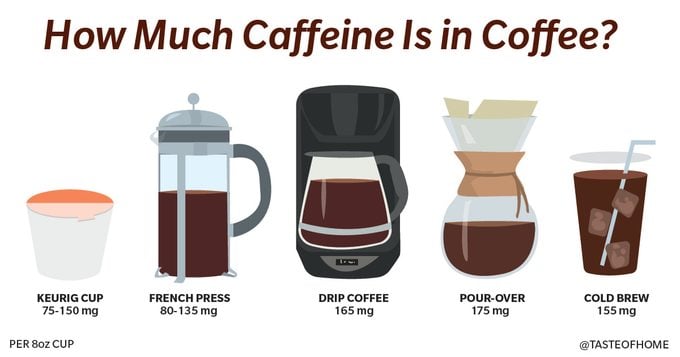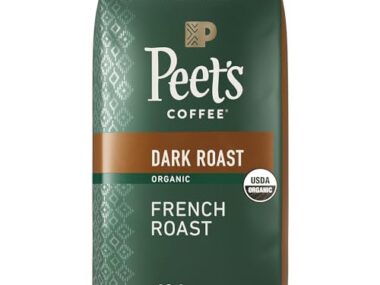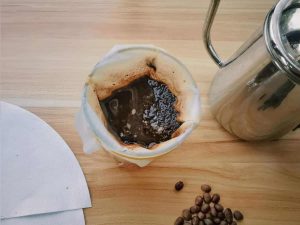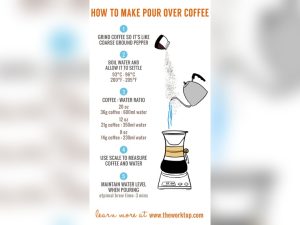You probably start your day with a cup of coffee, but have you ever wondered how much caffeine is actually in that cup? Knowing the caffeine content can help you manage your energy levels and avoid those unwanted jitters or sleepless nights.
Whether you prefer a strong espresso or a smooth drip coffee, the amount of caffeine can vary a lot. You’ll discover exactly how much caffeine is in one cup of coffee and what factors affect it. Keep reading to get the full picture and make smarter coffee choices every day.
Caffeine Amounts In Coffee
Caffeine is the main reason many people enjoy coffee daily. It helps increase focus and energy. But the amount of caffeine varies by coffee type and preparation. Knowing caffeine content helps you control your intake. This section explains caffeine amounts in different coffee cups.
Average Caffeine Content Per Cup
On average, one cup of brewed coffee contains about 95 milligrams of caffeine. This number can change based on cup size and brewing style. A small 8-ounce cup usually has less caffeine than a larger mug. Instant coffee tends to have less caffeine than freshly brewed coffee.
Caffeine In Different Coffee Types
Caffeine levels differ by coffee type. Arabica beans have less caffeine than Robusta beans. Light roast coffee keeps more caffeine than dark roast because roasting lowers caffeine. Cold brew often has more caffeine than hot brewed coffee because it steeps longer. Espresso has high caffeine concentration but is served in small amounts.
Espresso Vs Regular Coffee
Espresso contains about 63 milligrams of caffeine per 1-ounce shot. Regular brewed coffee contains about 95 milligrams per 8-ounce cup. Even though espresso has more caffeine per ounce, people drink it in smaller amounts. A typical coffee cup usually has more total caffeine than a single espresso shot.

Credit: www.tasteofhome.com
Brewing Methods And Caffeine
The way you brew your coffee changes how much caffeine ends up in your cup. Different brewing methods pull caffeine from coffee grounds in unique ways. Some methods use hot water quickly, while others use cold water slowly. This affects the caffeine strength and taste.
Understanding how brewing methods affect caffeine helps you choose the right coffee for your needs. Here are details on popular methods and their caffeine effects.
Cold Brew And Pour-over Effects
Cold brew uses cold water and a long steep time, usually 12 to 24 hours. This slow process extracts a high amount of caffeine. Cold brew is smooth but often stronger in caffeine than hot coffee.
Pour-over coffee uses hot water poured over grounds slowly. This method gives control over brewing time and temperature. It can extract more caffeine than some methods because the water passes through grounds evenly. Pour-over coffee often tastes clean but can be quite strong.
French Press Vs Other Methods
The French press steeps coffee grounds in hot water for about four minutes. It allows oils and fine particles to stay in the coffee. This adds flavor but does not extract as much caffeine as cold brew or pour-over.
Compared to drip coffee makers or espresso, the French press usually has moderate caffeine levels. It offers a balance between flavor and caffeine strength. The grounds stay in contact with water longer, but the filter type limits caffeine extraction.
Roast Level Impact
The roast level of coffee beans affects their caffeine content. Roasting changes the beans’ chemical makeup. This process impacts how much caffeine ends up in your cup. Different roast levels give distinct flavors and caffeine amounts. Understanding these differences helps you choose the right coffee for your needs.
Light Roast Caffeine Levels
Light roast beans keep most of their original caffeine. The roasting time is shorter, so less caffeine burns off. These beans often taste brighter and more acidic. A cup made from light roast usually has slightly more caffeine than darker roasts. For those who want a stronger caffeine kick, light roast is a good choice.
Dark Roast Caffeine Levels
Dark roast beans roast longer and at higher temperatures. This process reduces the caffeine content a bit. The beans become darker and oilier on the surface. Dark roasts have a bold, smoky flavor with less acidity. Although caffeine is slightly lower, the taste feels stronger. People who prefer a rich, deep flavor often select dark roast coffee.
Bean Varieties And Caffeine
Different coffee beans contain different amounts of caffeine. The two main types of coffee beans are Arabica and Robusta. Each variety has its own flavor and caffeine level. Understanding these differences helps explain why caffeine content varies in your cup.
Bean varieties play a big role in the caffeine you get. The choice between Arabica and Robusta beans influences the strength and taste of your coffee.
Arabica Vs Robusta Beans
Arabica beans are the most popular worldwide. They have a smooth, mild flavor with less bitterness. Arabica beans contain less caffeine, usually about 1.2% caffeine by weight.
Robusta beans are stronger and more bitter. They grow at lower altitudes and are easier to cultivate. Robusta beans contain almost twice the caffeine of Arabica, around 2.2% by weight.
Because of their higher caffeine content, Robusta beans can produce a more intense coffee experience. They are often used in espresso blends for added strength.
How Bean Type Affects Caffeine
The type of bean changes how much caffeine ends up in your cup. Coffee made with Robusta beans has more caffeine than Arabica coffee.
Even if the brewing method is the same, the bean type affects the caffeine level. This explains why two cups of coffee can taste different and have different effects.
Roasters often blend both bean types to balance flavor and caffeine content. Knowing the bean variety helps you choose coffee that fits your caffeine needs.
Serving Size And Caffeine
Serving size plays a big role in how much caffeine you get from coffee. The amount of caffeine in a cup depends on the size you drink. Small cups have less caffeine, while larger cups contain more. Understanding serving sizes helps control your caffeine intake.
Standard Cup Sizes
A typical coffee cup holds about 8 ounces (240 ml). This is the size most studies use to measure caffeine. A standard 8-ounce cup has roughly 95 mg of caffeine. Espresso servings are smaller, around 1 to 2 ounces, with about 63 mg of caffeine per shot. Larger coffee cups, like those at cafes, can range from 12 to 20 ounces or more. These larger sizes hold more caffeine simply because of the greater volume.
How Serving Size Changes Caffeine Intake
The bigger the cup, the more caffeine you consume. For example, a 12-ounce cup contains about 142 mg of caffeine. A 16-ounce cup has nearly 190 mg. Drinking multiple cups adds up quickly. A small increase in size can double your caffeine intake. Pay attention to the cup size to avoid too much caffeine. This helps manage energy levels and sleep quality.
Coffee Vs Soda Caffeine
Caffeine is a popular stimulant found in many drinks. Coffee and soda are two common sources. Both provide caffeine but in different amounts. Understanding their caffeine content helps you make better choices. Here, we compare caffeine in coffee and soda to see how they differ.
Caffeine In Coke And Diet Coke
A 12-ounce can of Coke has about 34 mg of caffeine. Diet Coke contains slightly more caffeine, about 46 mg per 12-ounce can. Both sodas have less caffeine than a typical cup of coffee. The caffeine amount in soda is consistent across servings. Soda offers a milder caffeine boost compared to coffee.
Comparing Coffee And Soda
A standard 8-ounce cup of brewed coffee has around 95 mg of caffeine. This is nearly three times more caffeine than a can of Coke. Coffee’s caffeine level varies with bean type and brewing method. Soda caffeine remains steady but is lower than coffee’s average. Coffee delivers a stronger and longer-lasting energy lift.
Health And Safety
Understanding the health and safety aspects of caffeine intake is important. Coffee contains caffeine, a natural stimulant. It affects the brain and body in different ways. Moderate caffeine can boost alertness and mood. Too much caffeine can cause health issues. Knowing safe limits and warning signs helps you enjoy coffee safely.
Recommended Daily Caffeine Limits
Most adults can safely consume up to 400 mg of caffeine daily. This equals about four cups of brewed coffee. Pregnant women should limit caffeine to 200 mg per day. Children and teens need even less caffeine. Exceeding these limits may lead to health problems. Always consider your own sensitivity to caffeine.
Signs Of Excessive Caffeine Intake
Too much caffeine can cause jitters and nervousness. Rapid heartbeat and dizziness are common symptoms. You might also experience headaches or trouble sleeping. Stomach upset and frequent urination may occur. If these signs appear, reduce your caffeine intake. Seek medical advice if symptoms persist or worsen.

Credit: www.tasteofhome.com

Credit: prestocoffee.com
Frequently Asked Questions
How Much Caffeine Is In A Typical Cup Of Coffee?
A typical 8-ounce cup of coffee contains about 95 milligrams of caffeine. This amount varies by brewing method, roast, and bean type.
How Much Caffeine Is In A Coke?
A 12-ounce (355 ml) can of Coke contains about 34 milligrams of caffeine. This amount varies slightly by product type.
Is 200mg Of Caffeine A Lot?
200mg of caffeine equals about two cups of coffee. It is moderate but may cause jitters in sensitive people.
Is 2 Cups Of Caffeine A Lot?
Two cups of coffee typically contain 150-300 mg of caffeine, which is moderate for most adults. This amount can boost alertness but may cause jitters in sensitive individuals. Daily caffeine intake should not exceed 400 mg to avoid health risks.
Conclusion
A typical cup of coffee contains about 80 to 120 mg of caffeine. This amount can change depending on the bean type and brewing method. Light roasts usually have a bit more caffeine than dark roasts. Robusta beans contain more caffeine than Arabica beans.
Cold brew often extracts more caffeine than other methods. Knowing your coffee’s caffeine helps you enjoy it safely. Drink what feels right for your body and energy needs. Coffee gives a nice boost, but balance is key.








